An experience of anger
Anger, or anger, is perhaps the most dangerous emotion. When you are angry, you are most likely intentionally hurting other people. If you have someone experiencing anger and you know its reasons, then the aggressive behavior of this person will become clear to you, even if you condemn him for his inability to control his emotions. On the contrary, a person who makes unprovoked attacks on other people and does not feel anger at the same time will seem strange or even abnormal to you. Part of the experience of anger is the risk of losing control. When a person says that he was angry, this, apparently, can explain his regrets about what he did: “I know I shouldn’t have said this to him (to stab him), but I was beside myself - I just lost my head!” Children are specifically taught that when they are angry, they should not physically harm anyone. Children may also be taught to control any visible manifestations of anger. Boys and girls are usually told different things about anger: girls are taught to control their anger, and boys are encouraged to show it to those peers who provoke them to it. Adults are often characterized by how they deal with their anger: "restrained", "hot", "explosive", "fiery", "cold-blooded", etc.Anger can arise from different reasons. The first reason is frustration (nervous exhaustion), caused by numerous obstacles and obstacles and hindering progress towards the goal. Frustration can be specific to the task you are solving, or it can be more general in nature, determined by your lifestyle. Your anger is more likely to arise and will be stronger if you believe that the person who interfered with you acted arbitrarily, unfairly, or simply to spite you. If a person deliberately wants to make you frustrated or drives you to complete nervous exhaustion simply because he cannot understand how his actions can affect your performance, then you are more likely to experience anger than if you believe that he simply has no other choice. But the obstacle that causes frustration is not necessarily a person. You may become angry at the object or natural phenomenon that caused your frustration, although you may feel that your anger is less justified.
Most likely, your actions in a state of anger caused by frustration will be aimed at removing the obstacle through a physical or verbal attack. Of course, frustration may be stronger than you, and then your protest efforts will be meaningless. However, anger can still persist and you will direct it at the person - you can curse, hit, etc. Or you can show your anger by cursing and scolding this person when he is too far away from you. to punish you for such behavior. You can express your anger symbolically by attacking something you associate with, or directing your anger towards a safer or more convenient target - the so-called scapegoat.
The second reason for anger is a physical threat. If the person physically threatening you is weak and incapable of harming you, then you are more likely to experience contempt than anger. If the person physically threatening you is clearly stronger than you, then you are more likely to experience fear than anger. Even if your strengths are approximately equal, you can experience both anger and fear at the same time. Your actions in situations where your anger is caused by the threat of physical harm to you may be to attack the enemy, verbally warn or intimidate, or simply run away. Even in the case of running away, when you seem to feel fear, you may still feel anger.
The third reason for anger may be someone's actions or statements that make you feel that you are being harmed morally, rather than physically. An insult, rejection, or any action that shows disrespect for your feelings can make you angry. At the same time, the stronger you are mentally attached to a person who causes moral damage to you, the more you experience pain and anger from his actions. An insult from someone you have little respect for, or a rejection from someone you never considered a friend or lover can, in the extreme, evoke contempt or surprise. On the contrary, if you are offended by a person you cared about a lot, then you may feel sorrow or sadness at the same time as anger. In some situations, you may love the person causing you suffering so much, or be unable to be angry with him (or any person in general), that you will begin to look for rational reasons for his actions that are painful for you in your own actions, and then, instead of anger, experience a feeling guilt. In other words, you are angry with yourself, not with the person who hurt you. Again, as with frustration, if the person making you suffer does so intentionally, you are more likely to experience anger than if they acted unintentionally or in a state of loss of self-control.
The fourth reason for anger may be watching a person do something that goes against your core moral values. If you find one person's treatment of another immoral, you may experience anger even if you are not directly involved in the situation. A good example is the anger you may feel when you see an adult punishing a child in a way that is unacceptable from your point of view. If you adhere to other moral values, then the attitude of an adult towards the actions of a child, which seems too condescending to you, can also make you angry. The victim does not need to be as helpless as the child for you to become angry. A husband who leaves his wife, or a wife who leaves her husband, can make you angry if you think that spouses should stay together "until death do them part." Even if you wealthy man, then you may angrily condemn the economic exploitation of certain groups of the population that exists in your society or the system of providing numerous benefits to government officials. Moral anger is often based on self-righteousness, although we tend to use the term only when we disagree with the moral values of the person who caused our anger. Anger at the suffering of others, provoked by the violation of our moral values, is a very important motive for social or political action. Such anger, combined with other factors, can give rise to attempts to rebuild society through social reforms, political assassinations or terrorism.
The next two anger-producing events are related, but probably less important than those discussed above. A person's inability to live up to your expectations can make you angry. It doesn't harm you directly; in fact, this inability may not have a direct bearing on you. A clear illustration of this situation is the reaction of parents to the success of the child. The impatience and annoyance associated with a person's inability to follow your instructions or otherwise meet your expectations is not necessarily related to the pain caused by this inability - it is the person's inability to meet expectations that causes anger.
Another reason for your anger may be another person's anger directed at you. Some people tend to respond with anger to anger. Such reciprocity can manifest itself especially in cases where there is no obvious reason for another person's anger at you, or if their anger, in your estimation, is unjustified. Anger directed at you, which, from your point of view, is not as fair as it is from the point of view of another person, can cause you to react with strong anger.
We have listed only a few causes of anger. Depending on a person's life experience, his anger can have a variety of origins.
The experience of anger very often involves certain sensations. In his work on the physiology of anger, Darwin quoted Shakespeare: Blood pressure rises, the face may turn red, and the veins in the forehead and neck become more prominent. The respiratory rate changes, the body straightens, the muscles tense up, and there may be a slight forward movement in the direction of the offender.
In the event of a strong attack of anger or rage, it is difficult for a person to remain still - the impulse to strike can be very strong. While attacking or fighting may be typical elements of an anger response, they are by no means mandatory. An angry person can only use words; he may shout loudly, or he may be more restrained and only say some nasty things, or even show even more self-control and not betray his anger either in words or in his voice. Some people habitually direct their anger inward and limit themselves to joking at the person who provoked the anger or at their own. Theories about the reasons for such psychosomatic disorders It is argued that some diseases of the body occur in people who cannot express their anger, who make themselves victims of anger instead of directing anger at the one who provoked it. Psychologists are now paying a lot of attention to people who are supposed to be unable to express anger, and various therapeutic and quasi-therapeutic medical firms are specifically teaching people how to express their anger and how to respond to the anger of others.
Anger varies in strength - from mild irritation or annoyance to rage or rage. Anger may build gradually, starting with irritation and then slowly build up, or it may come on suddenly and manifest itself with maximum strength. People differ not only in what makes them angry or what they do when angry, but also in how quickly they get angry. Some people have "short fuses" and instantly burst into fits of anger, often bypassing the stage of irritation, regardless of what the provoking event was. Others may only experience irritation: whatever the provocation, they never fall into real anger, at least in their own estimation. People also differ in how long they experience anger after the provoking stimulus has disappeared. Some stop feeling angry quickly, while others, due to their nature, the feeling of anger persists for quite a long time. It may take such people several hours to calm down, especially if the thing that caused their anger disappeared before they had a chance to demonstrate their anger in full force.
Anger can manifest itself in combination with other emotions. We have already discussed situations in which a person may experience anger and fear, anger and sadness, or anger and disgust.
Some people get great pleasure when they are angry. They enjoy the atmosphere of conflict. The exchange of unfriendly gestures and words not only excites them, but is also a source of satisfaction. People may even enjoy exchanging blows in an ensuing fight. Intimate relationships can be established or restored between two people through an intense exchange of angry attacks against each other. Some couples after violent quarrels or even fights immediately enter into intimate relationship. Some forms of sexual arousal may occur at the same time as anger; however, it is not known whether this is normal or only characteristic of people with sadistic tendencies. Undoubtedly, many people experience a positive sense of relief from anger, as long as the anger stops after the obstacle or threat is removed. But this is not at all the same as enjoying the experience of anger as such.
The enjoyment of anger is far from the only affective model for this emotion. Many people feel dissatisfied with themselves if they get angry. Never fall into anger - this can be important rule their life philosophy or work style. People may be afraid to feel anger, but if they do feel or show it, they become sad, ashamed, or dissatisfied with themselves. Such people are usually concerned about the possibility of losing control of the impulses that make them attack other people. Their concerns may be justified, or they may exaggerate the harm they can or could cause. Although characteristic changes occur in each of the three areas of the face during the manifestation of anger, but if these changes do not occur simultaneously in all three areas, then it remains unclear whether a person really experiences anger. The eyebrows are lowered and drawn together, the eyelids are tense, the eyes stare intently. The lips are either tightly compressed or unclenched, giving the mouth slit a rectangular shape.
Brows
Picture 1
Eyebrows lowered and drawn together. On fig. 1 shows angry eyebrows on the left and frightened eyebrows on the right. Both angry and frightened eyebrows have their inner corners shifted towards each other. But when a person is angry, his eyebrows are lowered, and when he is afraid, his eyebrows are raised. In the case of anger, the eyebrow line may become kinked at an upward angle or simply fall down without any kink. Pulling together the inner corners of the eyebrows usually results in vertical wrinkles between the eyebrows (1). In anger, no horizontal wrinkles appear on the forehead, and if some grooves nevertheless become noticeable there, then they are formed by permanent wrinkles (2).

In an angry person, lowered and drawn together eyebrows are usually complemented by angry eyes and an angry mouth, but sometimes angry eyebrows can appear on a neutral face. When this happens, the face may or may not express anger. On fig. 2 both John and Patricia have angry eyebrows on a neutral face (left), a neutral face (center), and for comparison fearful eyebrows on a neutral face (right). Although the face in the photo on the right expresses concern or fear (as mentioned on the surprise page), the face in the photo on the left - with eyebrows pulled together and lowered - can have any of the following expressions:
- The person is angry, but tries to control or eliminate any manifestations of anger.
- The person is slightly irritated or his anger is in the initial stages.
- The person is in a serious mood.
- A person concentrates on something.
- If this is a short-term change in which the angry eyebrows appear for just a moment and then return to a neutral position, then this may be another colloquial “punctuation mark” that emphasizes a certain word or phrase.
Eyes - eyelids
Figure 3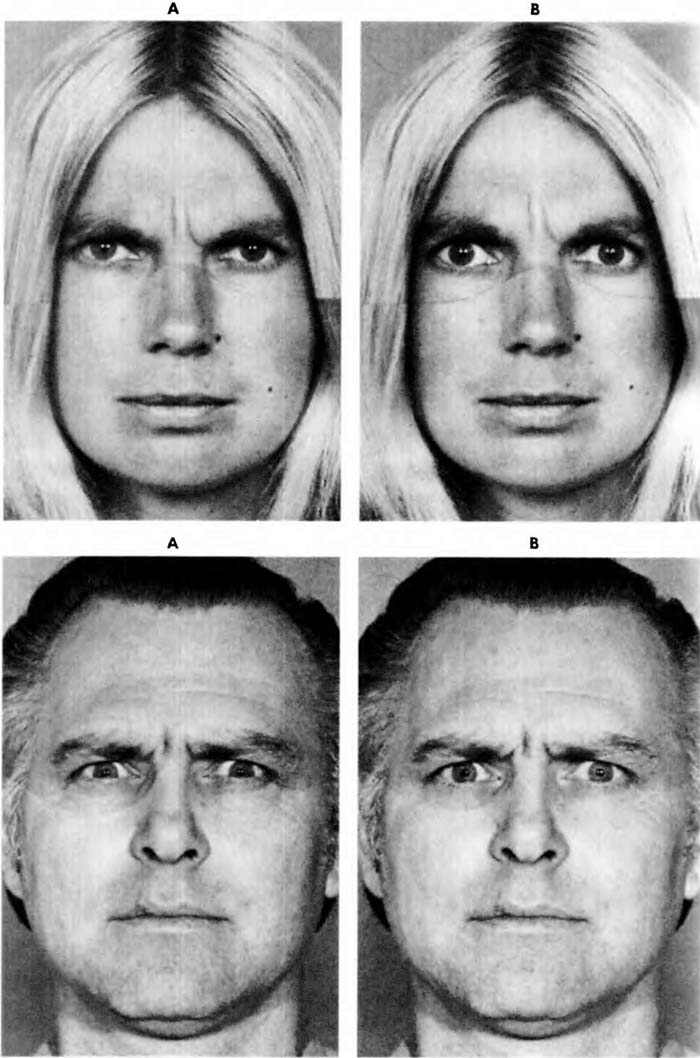
In anger, the eyelids are tense, and the eyes stare hard and hard. On fig. 3 Patricia and John show two types of angry eyes, less wide open in the left photographs and wider in the right. In all four shots, the lower eyelids are tensed, but they are raised higher in one of the angry eye shots (A) than in the other (B). In another shot of angry eyes, the upper eyelids look drooping. Angry eyes - the eyelids shown in fig. 3 cannot appear without the help of eyebrows, because lowered eyebrows reduce the degree of opening of the upper part of the eyes, causing the upper eyelids to droop. The lower eyelids may be tensed and raised, and a hard, staring gaze may occur on its own, but its meaning will be unclear. Maybe the person is experiencing mild anger? Or does he control the manifestation of anger? Does he have a worried look? Is he focused, focused, serious? Even when the eyebrows-forehead and eyes-eyelids (two regions of the face, as shown in Fig. 3) are involved, there is still uncertainty about the meanings of facial expressions. They can be any of the ones listed above.
Mouth
Figure 4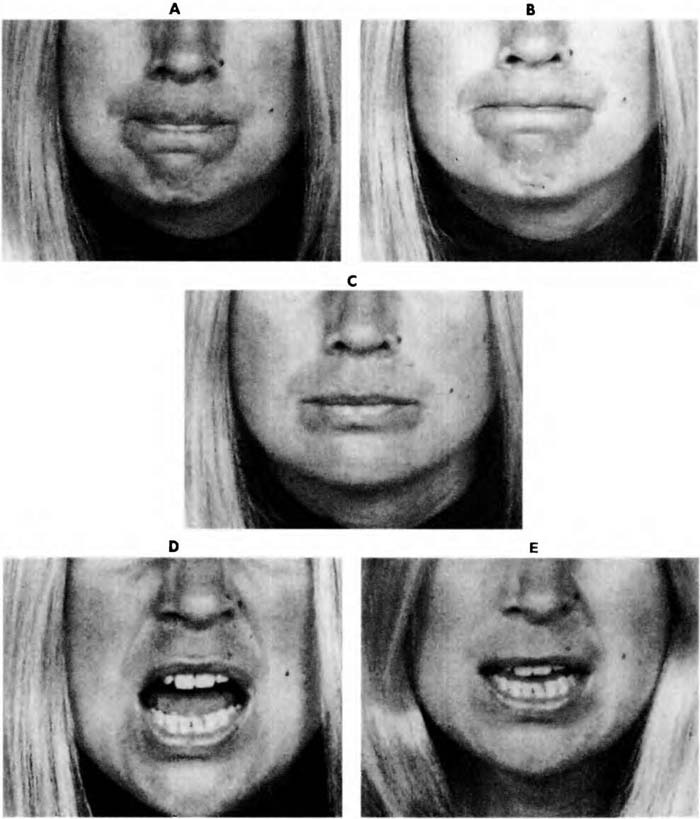
There are two main types of angry mouth. On fig. 4 Patricia shows a closed mouth with closed lips (top) and a slightly open rectangular mouth (bottom). A mouth with lips tightly closed to each other appears with two completely different types anger. First, when a person in one form or another carries out physical violence by attacking another person. Secondly, when a person tries to control the verbal and auditory manifestations of his anger and tightens his lips, trying to keep himself from shouting out or saying words that are offensive to the offender. An angry person keeps his mouth open when he tries to express his anger with words or shouts.
Usually such angry mouths appear on the face along with angry eyes and eyebrows, but they can also appear on a neutral face. However, the meaning of such a message will be ambiguous, as in the case when anger is expressed only by eyebrows or only by eyelids. If anger is expressed only through the mouth, then pursed lips can mean mild anger, controlled anger, physical exertion (as when lifting a heavy object), or concentration. The slightly open rectangular mouth also has an ambiguous meaning if the rest of the facial features remain neutral, since it can appear with exclamations that do not express anger (for example, shouts of approval during football match) or some speech sounds.
Two areas of the face
Figure 5
On fig. 3 we showed that if anger is manifested only in two areas of the face, eyebrows and eyelids, then the meaning of the message is ambiguous. The same is true for the case when anger is expressed only through the mouth and eyelids. On fig. Figure 5 shows composite photographs of Patricia in which anger is expressed only in the lower face and lower eyelids, and the eyebrows and forehead are taken from a neutral face. The meaning of these facial expressions can be any of the ones we have discussed above. The signals of a person expressing anger remain ambiguous if anger is not expressed in all three areas of the face. The expression of anger on the face differs in this respect from the expressions of emotion with which we have already met. Surprise or fear can be unambiguously expressed by eyebrows - eyes or eyes - mouth. Disgust can be unambiguously expressed by the mouth - the eyes. On the pages on sadness and joy, you will see that these emotions can also be uniquely expressed using just two areas of the face. And only in the case of anger, if the signals are given by only two areas of the face, there is an ambiguity of expression. Ambiguity when expressing anger using two areas of the face can be reduced by tone of voice, body position, hand movements or spoken words, and by understanding the context in which a particular expression occurs. If you saw a facial expression like in fig. 5 or fig. 3 and Patricia would deny that she was annoyed by clenching her fists, or if you were shown this expression immediately after you told her the news that you assumed she might not like, then you are probably right would appreciate her anger. Some people may have a tendency to express anger predominantly in one or another part of the face when they are able to control this emotion. When this is the case, people who know such a person well - family members or close friends - can correctly recognize facial expressions such as those shown in Fig. 3 or fig. 5. And although this expression will remain ambiguous for most people, it will be understandable to his relatives. Figure 6
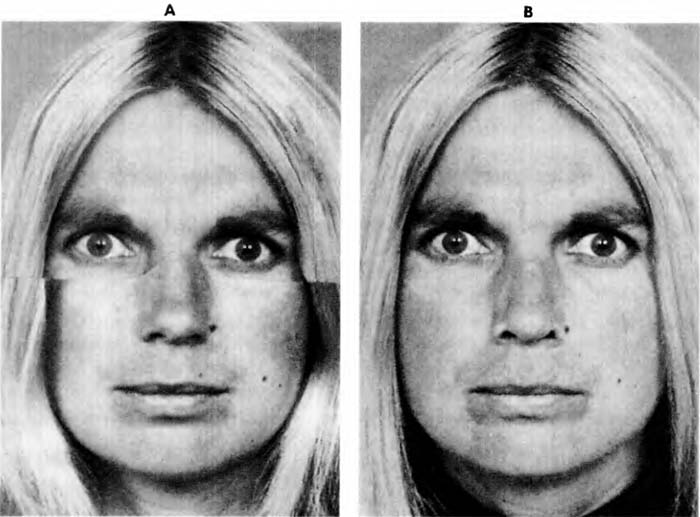
The ambiguity of anger in only two areas of the face can be illustrated with another set of photographs, where slightly different expressions of anger are shown in the eyelids. On fig. 6A, the eyes seem to bulge outward, and the lower eyelids of the eyes are tense, but not as much as in fig. 3. If this occurs with lowered eyebrows and a neutral mouth, as shown in fig. 6A, the message will be ambiguous. Patricia can express controlled anger, mild anger, strong intent or determination. If a slight tension is added to the lower part of the face, then the expression loses its ambiguity. On fig. 6B shows the same eyebrows and eyes as in fig. 6A, but the upper lip and corners of the mouth are slightly tense, the lower lip protrudes slightly forward, and the nostrils are slightly dilated. Figure 6B illustrates well that there may not be clear signs of anger in all three areas of the face. Eyebrows - forehead in fig. 6B show only a particular symptom of anger. The brows are lowered, but not drawn together, and we have just described how weakly tense the elements of the lower region of the face are. All these particular symptoms, which appear on the eyebrows - forehead and in the lower part of the face, complemented by tense lower eyelids and bulging eyes, are enough to identify anger.
Expressions of anger all over the face
Figure 7
On fig. 7 Patricia shows two types of eyes expressing anger - an eyelid with two types of an angry mouth. Comparing the top shots with the bottom shots, we see identical eyes - eyelids and different mouths. Comparing the left and right photos, we see the same mouth, but different eyes.
As we have already explained, this or that type of angry mouth is observed in a person depending on what he does. The closed-mouthed display of anger, as shown in the above pictures, can occur when the person is physically violent or if they are trying to suppress the urge to scream. On bottom pictures anger is shown, accompanied by screams and a stream of words. The wider angry eyes in the right shots make their messages a little more expressive.
Anger Intensity
The intensity of anger can be reflected in the degree of tightness of the eyelids or in how much the person's eyes are bulging. It can also manifest itself in how tightly the lips are closed. On fig. 7 the lips are compressed quite strongly, we see swelling under the lower lip and wrinkles on the chin. With milder anger, the lips do not tighten as much, and the bulge under the lower lip and wrinkles on the chin become less noticeable or not visible at all. Such an expression of anger is shown in Fig. 6b. An open mouth is also an indicator of the intensity of anger. Less intense anger may also be reflected in only one part of the face or only in two parts, as shown in Fig. 3 or fig. 5. But, as we said, it will still be unclear here whether light man anger, whether he is angry enough, but controls the expression of anger on his face, or not angry at all, but simply focused, determined or confused.Showing anger with other emotions
The mixed expressions shown in the previous chapters were created by the fusion of two emotions reflected in different areas of the face. Even limited in its manifestation to only one part of the face, each such emotion was transmitted in a complex message sent to the observer. But if we are talking about anger and the expression of anger does not appear in all three areas of the face, then the transmitted message becomes ambiguous. As a result, in mixed forms of anger expression, when one or two areas of the face reflect another emotion, the message of anger is usually dominated by another emotion (another consequence of this is that anger is easily masked: to reduce the unambiguity of expression, it is enough to control or hide only one area of the face) - We will give several examples of mixed emotions in which the message of experiencing anger is almost invisible. But there are two exceptions where anger messages remain highly visible. First, in the case of a combination of disgust and anger, the part of the message that conveys anger is retained. This may be because the combination of disgust and anger occurs quite often, or because there is a similarity in facial expressions and similarity in the situational contexts of the two emotions. Secondly, the mixture of anger and disgust can be created in another way. Creating such a combination does not necessarily require different areas of the face to display different emotions. This can occur when the manifestations of two emotions are mixed in each of the areas of the face. Since the message of anger appears in all three areas of the face when such a combination is created, it is in no way obscured or suppressed by another emotion. This combination of emotions is shown in Fig. 8. Figure 8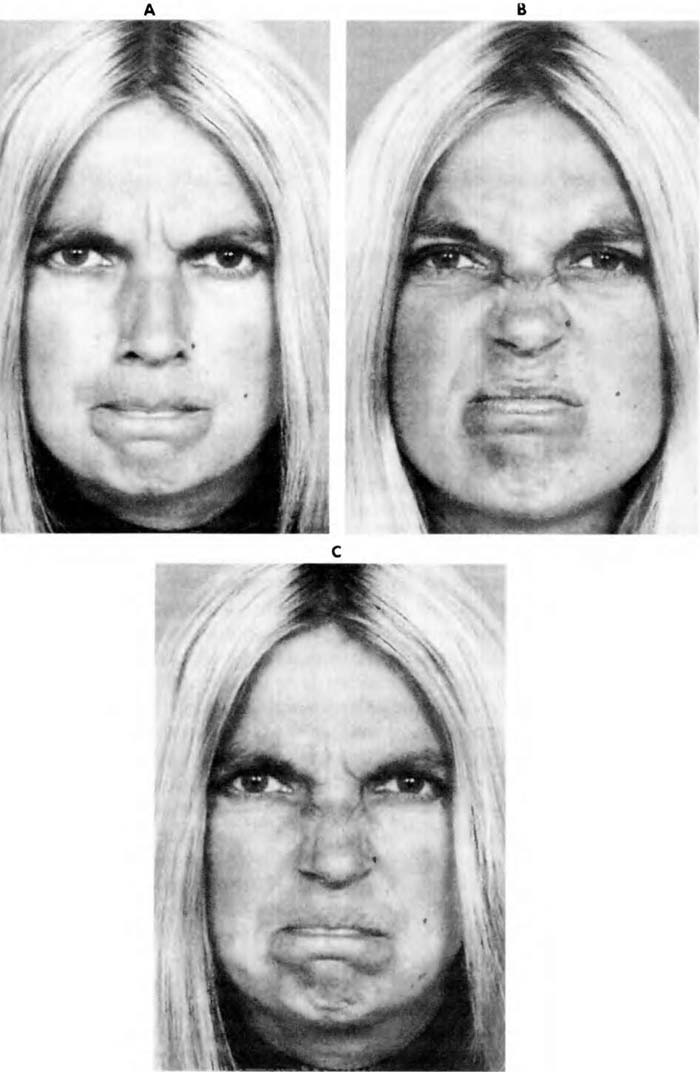
Most often, anger is complemented by disgust. On fig. 8C Patricia displays anger with disgust, with both emotions blending in each area of the face. It seems that she wants to exclaim: "How dare you show me such a disgusting thing!" This figure also shows expressions of anger (8A) and disgust (8B) for comparison. Look closely at the mouth in fig. 8C. We see closed lips - as in the manifestation of anger, and raised upper lip- as in the manifestation of disgust. Patricia's nose is wrinkled, indicating disgust. The lower eyelids are slightly tense, as in the expression of anger, but the bags and folds under the eyelids characteristic of the expression of disgust are created by wrinkling the nose and lifting the cheeks. The upper eyelids are lowered and tense - this change occurs either with anger or disgust. But lowered eyebrows are intermediate between an expression of anger and an expression of fear - they are only partially brought together. Figure 9

On fig. 9 John shows two other mixed expressions of anger and disgust. They appear in pure form in different areas of the face, and not due to manifestation in each of the areas. On fig. 9A anger express eyebrows and eyes, and the mouth - disgust. On fig. 9B John shows a combination of contempt and disgust: disgust expresses the mouth, and anger expresses the eyes and eyebrows.

Figure 10
You can be both surprised and angry at the same time. Suppose that John was already surprised by something, and then some other unexpected event occurred that provoked anger. On fig. 10 John shows anger and surprise, with surprise expressing his mouth and anger expressing his eyebrows and eyes. Note, however, that the element of surprise dominates the message. We're not sure if John is angry. This facial expression could also occur in the case of bewildered surprise (remember that lowered and drawn together eyebrows can also express bewilderment). Figure 11

Fear and anger can be triggered by a variety of triggers and threats, and these emotions are sometimes mixed for a while while the person is trying to cope with the situation. On fig. 11 we see two such expressions of anger and fear. On fig. 11B and fig. 11C fear expresses the mouth, and anger expresses the eyebrows and eyes. Again, pay attention to the fact that in the general expression of the face, anger does not play a dominant role and is much weaker than fear. In fact, these two facial expressions (11B and 11C) could occur in the complete absence of anger and be caused by fear and bewilderment, or just fear, on which the person concentrates all his attention. Patricia's face in fig. 11A is shown because it shows a combination of elements of fear and anger (frightened eyebrows and eyes, an angry mouth), but this is one of those faces that makes us doubt that they really express a mixture of these two emotions. It is more likely that this combination would have occurred if Patricia had been frightened and tried to hold back her screams by pursing her lips tightly to try to control her fear.
Anger can also be mixed with joy and sadness.
Summary
Anger manifests itself in each of the three areas of the face (Fig. 12).
Figure 12
- Eyebrows lowered and drawn together.
- Vertical wrinkles appear between the eyebrows.
- The lower eyelids are tense and may or may not be raised.
- The upper eyelids are tense and may or may not be drooping as a result of the drooping of the eyebrows.
- The eyes are fixed and may be slightly bulging outward.
- The lips can be in two main states: tightly compressed, the corners of the lips are straight or down; or the lips may be parted (forming a rectangular mouth) and tense - as in a cry.
- The nostrils may be flared, but this sign is not characteristic only of anger and may appear when expressing sadness.
- There is ambiguity of expression if anger does not appear in all three areas of the face.
"Construction" of facial expressions
With these exercises, you will learn how to give angry faces ambiguous expressions.- Place part A on each of the faces in fig. 12. You will get the same face as in fig. 5, which can express anger or have any other meaning we have discussed.
- Place part B on each of the faces in fig. 12. You will get an expression that you have not seen before - only the mouth expresses anger on such a face. It may be mild or controlled anger; this is how a face may look when muscles tense, concentrate, scream or pronounce some words.
- Place part C on the faces of fig. 12. You will get the same face as in fig. 2. And again, the message he sends will be ambiguous: controlled or mild anger, concentration, determination, etc.
- Place part D on the faces of fig. 12. You will get the same face as in fig. 3; it will also be ambiguous with the same choices listed in the previous paragraph.
Show photos
Read again the instructions for completing a similar task on the page of fear. You can now add disgust and anger faces and combinations of anger, disgust, fear and surprise. First, practice the following expressions of anger, disgust, and combinations of the two. When you learn to distinguish them without error, add expressions of fear and surprise to them. Practice until you get 100% correct answers.Anger as an emotion is negatively perceived by people. A person in anger rarely controls himself, as in principle and with the manifestations of other feelings. However, anger makes a person act badly towards those he is offended by. The feeling in question has reasons for its appearance and methods of control. How to deal with anger main topic this article.
Many people confuse anger with aggression. However, these concepts are different. The emotion that a person experiences is the same - there is indignation, indignation at what is happening. However, anger differs in the way it manifests itself.
Anger can be defined as internal state a person who is offended, dissatisfied with something, hates. Aggression is often associated with violence. If during anger a person tries to offend his offender, then during aggression he seeks to cause him physical or material harm.
In themselves, these emotions are similar, but there are differences. All about aggression can be read on the website psychological help psymedcare.com.
What is anger?
It is not difficult to recognize anger, as it often occurs in people who are unhappy with something. What is anger? This is a negative emotion, which is expressed in a flash of indignation and indignation at what is happening. Anger is a harbinger of aggression, when a person directly proceeds to commit negative acts.
We can say that anger is an emotion, and aggression is a violent action.
During anger, a person turns off his rational thinking, the rules of decency and morality. Instinctive mechanisms are turned on when a person directs destructive energy to the address of what caused his anger. In rare cases, a person controls himself, because often he believes that he is doing the right thing in a state of anger. He is not wrong, but other people should be punished for the offense they caused him.

Anger is an emotion of an aggressive nature, a direction towards an animate or inanimate object with the aim of destroying, suppressing or subjugating it. This negative emotion cannot last long. However, it completely covers the human consciousness, subordinating it to itself:
- The muscles of the face and body tense up.
- Fists and teeth are clenched.
- The face is on fire.
- The body tenses like a string.
- Everything is boiling inside.
At any moment, a person can explode, and the sensations that he experiences are like a “boiling kettle”, which is already whistling and ready to catch fire.
Anger is one way people communicate. Being unhappy own life, people splash it out on everyone who just touches them with something. Naturally, the response will be the same anger or even more, since the feelings of other people are already hurt. It turns out a vicious circle, when some splash out anger because of their own discontent on those who respond with the same anger that causes discontent of the first.
Anger has become the norm of modern society. However, this does not change the fact that anger radiates negative energy and leads to various kinds of disorders. Despite the danger and undesirability of communicating through anger, people continue to express it at every opportunity. And in all this confusion, it is very important to skillfully use that feeling that usually destroys a person and his life. It is important to learn to understand the nature of anger and be able to manage it for your own good.
Reasons for anger
When you observe the angry behavior of another person, the natural question arises: “Why are you angry?”. What are the causes of anger that so covers a person that he stops reasoning, thinking and remaining calm?
Anger is classified as a negative emotion, because in the conditions of the modern world, this expression of feelings is unacceptable. However, anger is a natural, natural feeling that is aimed at the survival of a living entity. If a person did not get angry, then he could not protect himself, his property or relatives.
However, over time, social foundations have changed, rules and frameworks have been invented that now restrain people in their natural manifestations. Anger cannot be eradicated from a person, because it continues to preserve his life, integrity and rights. However, society does not accept the expression of anger, since it is often associated with the commission of bad deeds that infringe on the rights and freedoms of others.
Psychologists distinguish main reason anger is aggression that occurs on an external stimulus. Sometimes anger can be provoked by fear and other negative emotions. The body begins to produce a large number of energy, the pulse quickens, the skin turns pale or red. All of these are natural manifestations of anger.
Anything can lead to a state of anger and anger:
- Getting a bad grade in school.
- Criticism of a loved one.
- Rejection of feelings and refusal to create love relationships.
- Salary delay.
- Dismissal.
- Aggressive attitude of others.
- Infringement of human freedom, etc.
People have a negative attitude to anger, because under its influence a person rarely controls his actions. And in a state of anger, you can only do bad things - harm or commit violence. IN cultural society this behavior infringes on the rights and freedoms of others, so there is constant propaganda that anger should be managed.
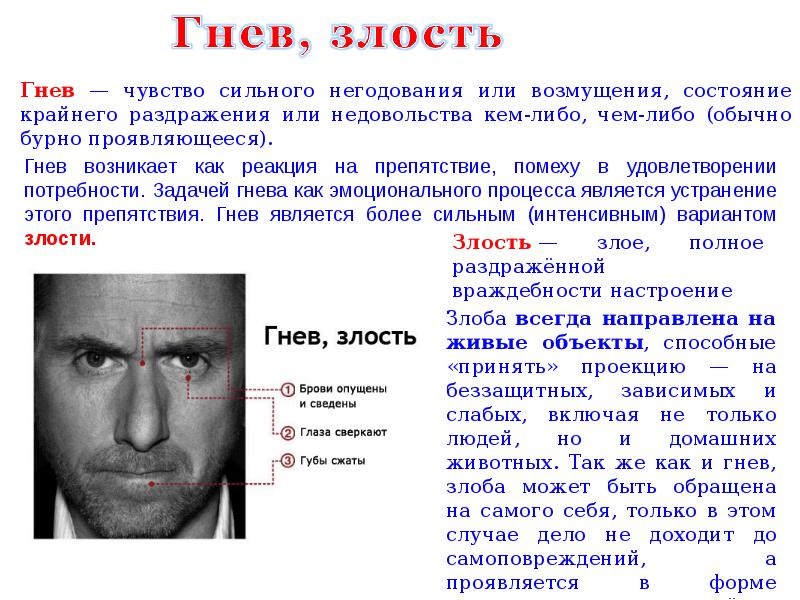
A common cause of anger is called frustration - when a person cannot achieve his goals due to external circumstances or interference caused by another individual. Frustration is failure, disappointment, lack of purpose. A person in this situation is angry at those people or circumstances that have become obstacles in achieving the desired.
Often, anger is directed towards removing these obstacles. It can be both verbal and physical.
Another reason for anger can be a situation where a person succumbs to moral pressure. This phenomenon is common in modern society. How else can you express your anger in a cultured society where any physical abuse is punished? Only words in the form of criticism and dissatisfaction. People have already learned how to skillfully operate with words and put pressure on others so that they have a natural feeling of anger when their freedom, rights and dignity are suppressed.
In the emergence of anger often plays important role attachment to the person who offends. If close person refuses, offends, demonstrates disrespect for the feelings of a partner, then there is internal indignation, resentment, anger. The more expected of the other person, the stronger the anger becomes when expectations are not met.
Strong anger leads to nervous exhaustion. Therefore, first of all, one should learn to cope with anger by the person who experiences it.
Anger management
Modern society is arranged in such a way that respect, good nature, calmness, etc. are acceptable manifestations of people. Such a feeling as anger is one of those manifestations that should be suppressed. That is why there is an active development of methods for managing one's own anger.
Unfortunately, people still cannot manage anger, which is quite natural:
- It is impossible to suppress what is given to man by nature. Fighting anger is like fighting your own appetite. Sooner or later, a person will not stand it and will break.
- It is impossible to get rid of what subjugates a person. While the individual is in a state of anger, he completely surrenders to his own feelings.
- You can't fight what feels right. No man will give up what feels right to him. Only at the end of the action of anger can he see negative sides their actions.
Anger management is possible only when the person himself, in a state of anger, does not want to succumb to his own emotions and does not consider it right to commit bad deeds. In this case, you can use all the exercises that psychologists offer.

Negative emotion appears in a situation where it seems that something is wrong and should be corrected. At the stage of the initial appearance of emotion, a person faces an unconscious choice: to calm down and go into decline, or to succumb to anger and reach a state of rage. It is at this moment that anger can be controlled before it has consumed the person.
If the individual succumbs to his own anger, then he experiences and performs many actions:
- Nerves are compressed, there is a feeling of lack of air.
- There is a desire to fight, crush, break, jump, run, etc.
- There is a surge of discontent and indignation.
- The voice becomes hoarse and choked.
Society condemns precisely the actions that a person commits in a state of passion. After all, under the influence of anger, he commits destructive acts. That is why it is recommended to move away from aggressive or evil person until he releases all his emotions.
Anger is sometimes divided by gender:
- Male aggression is perceived as a manifestation of strength.
- Female aggression is considered a manifestation of weakness and irrationality.
Although we are talking about the same causes and manifestations of anger. Only in society is one sex allowed to manifest it, while the other is prohibited.
Anger quickly arises and just as quickly passes. Society's attitude towards him is based solely on the actions that a person performs in a state of anger. If they bring destruction and pain to others, then anger was bad. If a person has done a noble deed, then people praise him.
Anger manifests itself in all people. However, in order to control its expression, various manipulative slogans are invented. For example, it is believed that a person matures when he learns to manage anger. In other words, it is beneficial for society that people seek to restrain their natural emotion, which disturbs the peace of citizens.
How to deal with anger?
Should I learn to manage my anger? On this question each must answer for himself. It is worth noting only one advantage that a person receives when he learns to cope with anger - he can now control his actions in any situation.
To cope with anger, it is necessary to stop its development at any stage.
- First, you can stop anger at the stage of the appearance of a situation that causes negative emotions. You can end a conversation with a person who is annoying. You can briefly leave the room where unpleasant events occur. As soon as you feel that you are starting to be aggressive, you should isolate yourself from the negative situation.
- Secondly, you can stop anger at the stage when it either subsides or starts to rage. Tell yourself that you don't want to be angry, and start doing whatever you can to help you do that.
Additional techniques to eliminate anger can be:
- Listening to calm music.
- Restoration of breathing.
- Seclusion for the purpose of relaxation.
- Relaxation of all muscles of the body.
- Thinking about the situation in order to solve it, and not to find the guilty ones.
- Meditation.
- Mental movement to places where it is pleasant to be.
- Switching attention.
Train yourself to see in anger not a personal insult, but the natural aggressiveness and savagery of people. People are not trained to manage their anger, so they use it like little children who are just naughty because they didn’t like something.

If something annoys you, you should not accumulate it in yourself - say it in a non-rude and human way. Your task is not to swallow your own anger in order to be civilized outwardly. You have to learn to get rid of the charge negative energy through calm conversation.
How to make your anger noble?
- Admit that you are angry.
- Understand your anger. What are the reasons for its occurrence? What made you angry?
- Use your anger to your advantage. Focus on solving the problem and use anger as a source of energy for further action.
Make your anger a helper that will accompany you until you solve the problem that has arisen. Indeed, in the whole situation, when something annoys you, the important thing is that there was just some kind of problem. And as long as you spend your energy and time expressing dissatisfaction with the other person, you are not solving the problem. You are trying to offend, blame, humiliate someone, but this has nothing to do with the situation that made you angry. It is better to direct your anger towards solving the problem, and not just offending the other person.
Outcome
Speaking about anger management, people often point out that it is necessary to suppress it. However, scientists say the opposite: the result of suppressed emotions can be psychosomatic diseases associated with the cardiovascular system. Heart attacks and strokes are often associated with unexpressed negative emotions.
At the same time, there is an opinion that anger cannot be expressed every time it appears. Because a person develops the habit of not holding back his emotions, but freely pouring them out on others. In its turn aggressive person begins to take pleasure in the suffering of others, which in the future causes him to provoke or look for situations where he can again be aggressive.
What to do with own emotions anyway, it's up to each person to decide. However, it should be understood that the constant experience of negative emotions leads to serious diseases that can affect life expectancy.
Just because a person isn't yelling at you, throwing fists at you, or throwing dishes on the floor doesn't mean they aren't angry. It is possible that he is holding back his emotions, but the accumulated anger is even worse than the expressed! So it’s not at all superfluous to find out what are examples of anger, which may indicate that a person in his soul is very angry with you.
Examples of Anger: Learn How Anger Manifests
Consider what are examples of human anger. If your interlocutor has his arms crossed very high, almost on his chest, it means that he is in a state of sharp denial of the problem under discussion and is hostile.
This posture may remind you of a child or teenager asserting their independence in an argument with their parents. At such a moment, the quality of the voice usually changes dramatically. The person begins to speak more aggressively, and the content of his speech clearly indicates an increase in anger.
In a state of anger or hostility, another signal of body language appears - a person clenches one or both fists of crossed arms. If you see that the interlocutor is literally hugging himself, do not think that he has become cold, this a prime example man's anger.
And, finally, some hand gestures indicate the growth of anger and the fact that the interlocutor is trying to establish control over the situation. The easiest way to recognize anger is by tapping your fingers.
You have probably noticed that a person, impatiently waiting for the waiter to return to his table, who must take the order, begins to drum his fingers on the table. The angry boss clenches her fist and symbolically (or even really) hits the table with it. This clear example man's anger and a sign of aggression.
Someone hits the palm of the other hand or the arm of a chair with their fist. Sometimes people tap on some surface not with a fist, but with an open palm. Such gestures appear not only at those moments when people are angry at emotional level, but also when it seems to them that events are developing in an undesirable way for them, that they lose control over what is happening.
Another example of a person's anger is the "pointing finger". I do not mean to say that simply pointing a finger at someone or something is a signal of anger. In anger, this gesture becomes sharp and even threatening. Noticing such behavior from the outside, it may seem to you that one of the interlocutors strikes the other with a dagger or sword.
The gesture can be directed at someone or something, or at oneself. The sharper this gesture, the more intense the anger experienced by the person. If your friend makes a similar gesture and points his finger down, then his anger has reached the limit. In some cases, such a gesture is a harbinger of real physical aggression.
Examples of Anger: Verbal Signals of Anger
As we have said, anger prevents a person from listening carefully to the interlocutor. Since I am interested in resolving the conflict with the interlocutor, I need to understand what barriers separate us from solving the problem. I need to identify verbal evidence that the interlocutor is angry.
The most common examples of anger we think of are raising your voice, stern facial expressions, and aggressive non-verbal behavior. However, these are just the obvious symptoms. An angry person may react to a situation very coldly and calmly.
mental state anger becomes noticeable when the person begins to use diffuse, disguised remarks. For example, instead of talking about a specific issue that you raised, he may complain that you touched on this topic, or say that he does not want to talk about it now. This is a verbal example of anger.
Of course, if you are talking about a complex, subtle topic in front of strangers or with limited time, then you may indeed have made a mistake. There is no need to discuss such a topic in such an environment. But if the interlocutor asks why you brought up this topic, instead of answering your question, it is quite possible that he is withholding important information from you.
I often cooperate with the police. I have always been interested in a situation in which a person does not deny his unseemly act, but instead attacks the facts contained in his case. The interrogated did not refute the crimes they had committed, but answered: "You cannot prove it."
Remember when you yourself were told: “This is not proof,” “They have no proof,” “You can’t prove that I did it.” Suppose there is a product on the market that the consumer protection society has determined is dangerous to people.
You can hear the manufacturer defending the product, claiming that the test data is unreliable, that the results were misinterpreted, and that the testing agency was bribed. Note that the company does not provide alternative evidence and even states: “Well, such a hype will only benefit us” or “We don’t have enough material.”
Verbal examples of anger. A person in a state of anger tries to regain control over the situation. At the same time, he tries to avoid solving a truly important problem.
Another distraction tactic is used by a person who starts arguing about petty or trivial issues. This is also a prime example of anger. He may claim that his interlocutor incorrectly names the time or even the date of a particular event. Or incorrectly describes his behavior.
Or incorrectly names the number of repetitions of a certain action. Or is mistaken about the cost, volume, or value of something. In any conversation, you can find a lot of problems that are not related to the main topic, on which you can start a fierce argument and unleash a conflict.
Of course, an aggressive reaction can be very personal. This is a very destructive example of anger, which does not allow you to find mutual language and come to a compromise.
Examples of Anger: Nonverbal Signals of Anger
Let's take a look at what non-verbal signals of anger are. There are two positions of the head showing that in emotional reaction interlocutor there is a certain hostility.
If the conversation touches on a controversial issue, you may notice that the other person tilts their head slightly. At the same time, he clearly sticks out his chin. This is an example of anger. Here is a person who shows aggression or feels a sense of hostility towards you or the topic under discussion.
This position of the head and chin can be seen before a real fight or a violent quarrel. Watch the players of the opposing teams during an intense football or hockey match.
When they communicate with each other on the playing field, you will certainly see such an aggressive head position in one or both of the participants in the skirmish. Well, then everything is clear - they tear off their gloves, throw aside their helmets and start hitting each other!
Non-verbal cues anger. Two examples of anger and hostility:
1) the interlocutor tilts his head slightly, while sticking out his chin;
2) compressed jaws and nodules on the cheeks.
There is another example and sign of anger - the position of the head and chin, indicating that a person is experiencing feelings of anger or hostility. But in this case, he tries his best to keep aggression under control. To recognize such a reaction, pay attention to the back of the interlocutor's jaws - to that part of them that is located near the ears.
As aggression builds up, the person tries his best to control himself, and you will notice the play of the jaw muscles in this area. This is because the person clenched their jaws and sometimes even gritted their teeth. The nodules on the cheeks are a clear example of anger and a sign of barely contained hostility and attempts to control oneself.
If you notice that the interlocutor slightly covers his eyes, looks askance, and his eyebrows form the letter "V", then anger or hostility is growing in the person. You will also notice that your interlocutor has tense muscles around the eyes, in the corners of the eyes and the upper part of the cheeks.
As an example of anger, remember how you went to church with your parents as a child and could not cope with natural restlessness. You wanted to turn around, whisper, fidget, sigh loudly, poke your brother or sister in the side - in a word, it was very difficult to sit still.
Remember what look your father or mother gave you in such a situation. You know him very well. This look said that serious troubles awaited you at home. Almost the same expression appears on the face of an interlocutor who is in a state of stress or is about to deceive you.
This is an example of anger and a sign of an increase or presence of aggression in a person's emotional reaction. If you see that a person is smiling at you, but at the same time looking at you like a father in church, then the interlocutor is insincere in expressing his feelings.
Anger is a fundamental human emotion that was given for the purpose of enabling the individual to survive in a wild and dangerous environment. Even in ancient times, anger helped people a lot, many obstacles were overcome. However, society developed, the need to express their negative emotions gradually decreased. It was not possible to get rid of anger completely, people and in modern world continue to artificially create trouble for themselves that arouse anger.
The meaning of the word "anger"
This is a negative emotion. You can even say that it has an aggressive character and is directed towards another person or object. If this is an object, then an individual can easily destroy it, if a person - offend, subdue.
Anger is when everything starts to boil and boil inside, the face turns red. It looks like a real bomb is about to explode. All hatred accumulates, all insults - they cause Negative consequences. The most dangerous thing is that in anger a person cannot always control his emotions. Sometimes everything comes to aggression, the individual is in and does not understand what he is doing. At times like this, it's better to have no one around. With a clouded mind, you can do anything, harm and even cripple.
Usually aggression does not last long. It's an instant impulse. A person quickly lights up and quickly fades away. However, anger is no joke. If the individual is frequently affected by this emotion, it is best to consult a physician.
Anger: what are the causes?
Aggression builds up in a person various reasons. Perhaps something did not go according to plan at work, at home it is difficult to find a common language with a loved one. The definition (what anger means) hardly conveys all the feelings that a person experiences during a breakdown. Even an elementary trifle can sometimes lead to an “internal explosion”. What are the causes of anger?

1. Contrasting Beliefs
The character of a person begins to form from childhood. We are all brought up differently, everyone is taught something, something is explained. This forms in a person the concept of morality, rules, principles. However, the beliefs of one individual do not always correspond to the rules of behavior of another. The brain is programmed like a computer, and when the system encounters an unknown concept, it starts to slow down. So is man. If he meets a belief that is not like what he is used to, he perceives this as a threat, a danger. As a result, anger wakes up - an emotion that definitely does not decorate us.
2. Fear
Another reason for aggression is subconscious fear. It is worth noting that in the modern world, a person very often creates problems for himself. Let's take a simple example. The man settled down Good work, everything is going great. However, for some reason, he begins to fear that he will be fired. All these feelings gather inside and turn into manic fear. What happens next? The boss calls the employee to him to point out a mistake or praise. At this time, something begins to happen in a person’s thoughts - all feelings are sharply intensified, he winds up that the boss is calling to him to fire him. As a result, anger is provoked. This is not surprising, a person perceives fear as a danger.
3. Stress
Stress is most often experienced by people with good manners. Surprisingly, this is true. Such individuals do not express their negative emotions, everything accumulates inside - resentment, pain, fear. A person tries to be correct, does not be rude to others, does not raise his voice, does not show his displeasure. You can not do it this way. You can't hide everything inside, because one day "the bomb will explode." This cannot be avoided. What is anger? This is a huge amount of negative emotions that accumulate in the soul over time. If you do not speak out from time to time, then the day will come when a person will simply break loose and turn from a decent individual into a real beast.

4. Feeling good
No matter how strange it may sound, the cause of anger can be a person. Illness, aching pain that you have to endure - all this negatively affects self-control and creates the prerequisites for a sharp change in mood. The end result is anger and anger. A person simply begins to annoy everything around, it seems that everyone wants to harm him. Here everything is woven into one knot - stress, fear, beliefs.
How to conquer anger?
Anger is as much a human emotion as joy or sadness. It is completely impossible to get rid of it. Even if someone succeeds, the individual feels inferior. The peculiarity of the human essence lies in the fact that he must show all his emotions in order to learn self-control. Anger is not the best emotion, there are several ways to protect yourself from sudden outbursts of rage so as not to harm others.

1. Learn to listen to yourself
Anger always has a precursor. It could be Bad mood, well-being or irritability. You need to learn to listen to yourself and see these moments in order to avoid a sudden outburst of rage. For example, you are talking to a person and you feel how everything starts to boil inside. This means that you start to get angry. How to proceed in such a case? There are several options for the development of events:
- change the topic, perhaps it is she who awakens negative emotions;
- end the conversation.
If you notice that in Lately rage is experienced more and more often - this is a wake-up call. What is anger? It's a violation psychological state. Keep a small notebook and write down all situations that make you irritable. At the end of the week, you need to analyze the records. If you yourself see that anger sometimes wakes up on empty place, then you can not let everything take its course. Maybe you just need a rest? Take a day off, spend it alone with your inner world. Read a book, take a bath, relax.
2. Control and good rest
Sometimes, in a fit of anger, a person can commit a terrible act, which he will later regret unspeakably. To avoid this, it is very important to learn to control your emotions. This does not mean that emotions now need to be suppressed. If you suddenly begin to feel irritation inside, try taking a few deep breaths and exhaling - breathing exercises calm the nervous system.
Another interesting option psychologists recommend for anger control. So, you managed to restrain yourself and not break into your interlocutor. Now we urgently go home or to another secluded place. We take a piece of paper and write a letter to the person who caused a violent negative reaction in you. Write whatever you feel. The more rage on paper, the calmer it will become in the soul. Then this letter must be burned.

Of course, it is important to remember about rest. The modern rhythm of life rarely leaves time to sleep. However, still find an extra hour or two a week for this. Fatigue can also cause an outburst of rage.
3. Exercise
It has been repeatedly proven that physical exercise excellent effect on the nervous system. Sign up for yoga, fitness or any other sport - several times a week will be enough for a person to splash out accumulated negative emotions.

Sometimes there is no time for sports. However, this does not mean that now you cannot get rid of rage. Cleaning around the house will help a lot - it's even better than fitness. A person concentrates on dirt, dust, how to get rid of it. There is a frenzied physical and mental stress. Psychologists confirm that cleaning is soothing. The person is satisfied with the work done, and the rage evaporates.
An easy way to calm down - breathing exercises with balloon. Inhale and exhale 10-15 times. This exercise can be practiced at work.
Summing up
The psychology of anger is a science that has been studied for a very long time. Every day something new and unknown is discovered in a person.

Helpful Hints:
- Make time for yourself. You don't have to think only about the people around you. Go shopping, go to the cinema or a cafe. In other words, sometimes you should treat yourself too.
- Don't create problems for yourself. Try to take things easier and remember: whatever is done is for the best.
- Rest - at least on weekends, try to sleep well and stock up on energy for the next week, then there will be less reasons for stress.
As for rage, you need to release it, just do it right so as not to harm anyone. This needs to be learned.
Man's anger- This is a negative emotional outburst, which is a harbinger of aggression. It is capable of literally bursting a person from the inside. Strong anger is often characterized by negative emotions with a flow of destructive energy, marked by a disabling of the ability to analyze actions. The sudden manifestation of such behavior in an individual causes bewilderment in the people around him, as well as anxiety in the person himself.
Anger is an emotion, often of an aggressive nature, directed towards something or someone with the aim of destroying, suppressing, subjugating (often inanimate objects). Often the reaction of this negative emotion is short-lived. During an emotional outburst in a person, the muscles of the face tense up; the body becomes stretched string; teeth and fists clenched, face begins to burn; there is a feeling that something inside is “boiling”, while there is no control over the mind.
Reasons for anger
Anger is a basic human emotion that was originally necessary for the individual to survive. However, due to the development of society, the need to express one's negative emotions gradually decreased, and humanity has not been able to completely get rid of anger. Unfortunately, in the modern world, people still continue to create artificial troubles for themselves that encourage them to express this kind of dissatisfaction.
The cause of strong anger is often the one that accumulates due to various circumstances. Even an elementary trifle can often lead to this negative emotion, or, which can also be the cause of this emotion.
Anger refers to a state of both physiological and psychological. In principle, its manifestation is attributed to the normal reaction of the psyche to an external stimulus. It is accompanied by increased heart rate, pallor or redness of the skin due to the production of a huge amount of energy by the body, which needs to be put somewhere.
There are no such people who never experience negative emotions and are always in a balanced state. Anything can throw you off balance: traffic jams, an unfair boss, childish pranks, bad weather, etc.
Anger management
Negative emotion occurs when a situation develops when something does not suit a person and there is a feeling that this can be dealt with.
Anger grows up to a certain point, after which there is either a decline to calm down, or a sharp upward jump, manifested in the form of fits of rage. There is such a stable expression - "choked with anger." This condition is characterized by nerve compression, shortness of breath. Negative emotional outbursts during this state are always marked by desire physical activity: crush, fight, run, jump, clench your hands into fists, break. At the moment of strong anger in a person, a bursting wave of indignation caused by an emotional outburst of discontent rises from the pelvis upwards, while reaching the chest. Such a condition will be characterized by a hoarse, choked voice, a feeling of constriction in the chest, coughing.
To the emergence of instant anger, which is beyond the control of a person, people are natural and not reprehensible, but the actions that are performed under the influence of this emotion are already condemned.
It can be almost impossible to manage anger in moments of aggression, since a person, being in a state, often does not understand what he is doing. At this time, it will be better if there is no one next to such an individual, since a person in aggression with a clouded mind is a danger and can harm and even cripple the people around him.
Anger and aggression often do not last long and are of a short duration. An individual in this state quickly "boils" and also quickly "extinguishes".
It is believed that if the emotion of anger is caused by a sense of justice at the time of the criminal act, that is commendable. In other cases, negative emotion is condemned and people are advised to be more restrained and show long-suffering.
Exist Interesting Facts about this emotion. Men's anger is perceived as a manifestation of strength, and women's similar behavior is treated as irrationality and weakness.
Anger and rage are among the most dangerous emotional outbursts. When a person experiences these emotions, he often deliberately harms other people, often losing control of himself, so the skillful management of anger and rage should be the primary task of individuals when negative emotions arise.
Adult personalities are often characterized by how they are able to cope with their indignation and give them such definitions: hot, reserved, explosive, cold-blooded, quick-tempered.
Manifestations of anger are marked by specific expressions of facial expressions:
- bare teeth, open mouth high on inspiration;
- drawn, lowered eyebrows;
- dilated eyes and focused attention on the object of aggression;
- horizontal wrinkles on the bridge of the nose;
- expansion of the wings of the nose.
How to deal with anger
To learn how to cope with anger, you should understand the cause of its occurrence and master effective techniques for removing it. aggressive behavior.
Anger is not the best human emotion, which always has a harbinger. There are several ways to protect yourself from sudden outbursts of emotional outbursts so as not to harm others. A person must learn to listen to himself and feel those moments when it is necessary to avoid sudden outbursts of negative emotion. It can be poor health, depressive mood, irritability. For example, an individual, talking with a person, feels how everything inside him begins to boil. This means the approach of anger, namely the violation of psychological balance, so you immediately need to evaluate true reason this emotion. Further, for maximum calm, you need to close your eyes for a while, trying to abstract from the outside world and begin to control your breathing by taking a deep and then slow breath.
How to deal with anger? There is an opinion that it is harmful for a person to restrain negative emotions in himself and it is better to get rid of them. In fact, it is not. Scientists have proved the following fact: the disruption of negative emotions in the immediate environment is akin to a drug and they give great pleasure to the aggressor. Frequent breakdowns of the individual on close circle make him want to do it with a certain frequency. Over time, the individual is no longer able to notice that he unconsciously creates situations in which he falls into anger. Noticing this feature, ordinary people, begin to avoid a scandalous person, and he, in turn, finds the same unbalanced and adoring such outbursts.
So how do you control anger? During the approach of negative emotions, you can go to the mirror and see which muscles are tensing. In a state of calm, you need to learn how to control the facial muscles: strain and relax them. When another flash of negative emotion occurs, the facial muscles should be relaxed.
How to get rid of anger? Bouts of anger are recommended to be eliminated by switching attention to something pleasant or distracting. It is necessary to mentally transport yourself to those places where you can be replenished with positive energy, and immediately transfer unpleasant conversations to neutral topics.
If an individual follows his emotions and does not fight with emotional outbursts, then in the future there is a risk of developing acute diseases of the cardiovascular system. This should be considered, as scientists have found a direct link between the occurrence of stroke and myocardial infarction after suffering an emotional outburst within 48 hours in people with acute coronary occlusion (blockage of the heart arteries).
The reason lies in the fact that periodically the arteries are attacked by stress hormones and experience pathological changes that lead to serious diseases. To avoid possible irreversible consequences, experts recommend carefully monitoring your nervous system and, if necessary, seek immediate medical attention.









